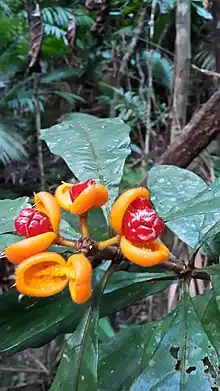Pittosporum rubiginosum
Pittosporum rubiginosum, commonly known as hairy red pittosporum, is an evergreen shrub in the family Pittosporaceae which is endemic to northeastern Queensland, Australia.
| Hairy red pittosporum | |
|---|---|
 | |
| Scientific classification | |
| Kingdom: | Plantae |
| Clade: | Tracheophytes |
| Clade: | Angiosperms |
| Clade: | Eudicots |
| Clade: | Asterids |
| Order: | Apiales |
| Family: | Pittosporaceae |
| Genus: | Pittosporum |
| Species: | P. rubiginosum |
| Binomial name | |
| Pittosporum rubiginosum | |
| Synonyms[3] | |
| |
Description
The hairy red pittosporum is a spindly shrub with a variable appearance as it grows. It usually reaches around 2–3 m (6 ft 7 in – 9 ft 10 in) in height, however it can (rarely) reach 6 m (20 ft).[4][5][6] The leaves are dark green above and usually purple underneath.[5][6] Both sides of the leaves are glabrescent, meaning that they are initially hairy but become hairless with age.[4][5] The size and shape of the leaves differ markedly from the juvenile stage to maturity − seedling leaves are densely hairy, those on a juvenile plant measure around 2.5 by 1.3 cm (0.98 by 0.51 in) while those of mature plants are about 24 by 8 cm (9.4 by 3.1 in).[4][5] All stages have very short petioles and are mucronate, that is, they have a fine sharp point at the tip of the leaf.[4][5]
The inflorescence is an umbel produced either terminally or in the leaf axils.[6] The fruit are yellow and split open to reveal a cluster of bright red seeds.
Taxonomy
This species was first described in 1840 by the English botanist Allan Cunningham, in a footnote in his paper dealing with the flora of New Zealand.[7] The species Pittosporum callicarpeum, published in 1925 by the Czech botanist Karel Domin, is now considered a synonym of this species.[8]
Etymology
The genus name Pittosporum comes from the Ancient Greek words πίττα (pítta) meaning "resin", and σπορά (sporā́), meaning "seed", and is a reference to the sticky seeds. The species epithet rubiginosum is derived from the Latin robiginosus, meaning "rusty red", which may be a reference to the colour of the seeds,[6] or to the colour of the hairs on new growth.[5]
Conservation
This species is listed by the Queensland Department of Environment and Science as least concern.[1] As of 14 April 2023, it has not been assessed by the International Union for Conservation of Nature (IUCN).
References
- "Species profile—Pittosporum rubiginosum". Queensland Department of Environment and Science. Queensland Government. 2022. Retrieved 14 April 2023.
- "Pittosporum rubiginosum". Australian Plant Name Index (APNI). Centre for Australian National Biodiversity Research, Australian Government. Retrieved 14 April 2023.
- "Pittosporum rubiginosum A.Cunn". Plants of the World Online. Royal Botanic Gardens, Kew. Retrieved 14 April 2023.
- F.A.Zich; B.P.M.Hyland; T.Whiffen; R.A.Kerrigan (2020). "Pittosporum rubiginosum". Australian Tropical Rainforest Plants Edition 8 (RFK8). Centre for Australian National Biodiversity Research (CANBR), Australian Government. Retrieved 14 April 2023.
- Cayzer, Lindy W. (2022). Kodela, P.G. (ed.). "Pittosporum rubiginosum". Flora of Australia. Australian Biological Resources Study, Department of Climate Change, the Environment and Water: Canberra. Retrieved 14 April 2023.
- Cooper, Wendy; Cooper, William T. (June 2004). Fruits of the Australian Tropical Rainforest. Clifton Hill, Victoria, Australia: Nokomis Editions. p. 402. ISBN 9780958174213.
- Cunningham, A. (1840). "Floræ insularum Novæ Zelandiæ precursor; or a specimen of the Botany of the Islands of New Zealand". Annals of Natural History. 4: 108. Retrieved 14 April 2023.
- "Pittosporum callicarpeum Domin". Plants of the World Online. Royal Botanic Gardens, Kew. Retrieved 14 April 2023.
External links
 Data related to Pittosporum rubiginosum at Wikispecies
Data related to Pittosporum rubiginosum at Wikispecies Media related to Pittosporum rubiginosum at Wikimedia Commons
Media related to Pittosporum rubiginosum at Wikimedia Commons- View a map of historical sightings of this species at the Australasian Virtual Herbarium
- View observations of this species on iNaturalist
- View images of this species on Flickriver